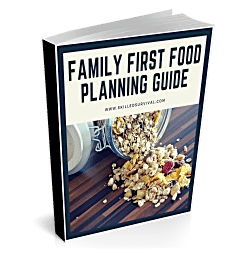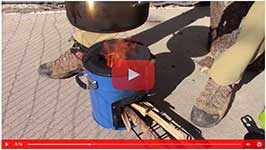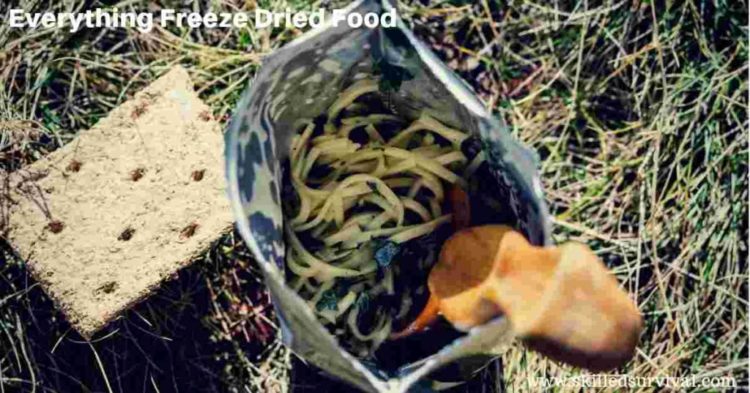 Today I’ve got something really special to share…
Today I’ve got something really special to share…
A Complete Guide To Buying (& Storing) Freeze-Dried Food For Emergencies
Because there’s a TON of confusion around freeze-dried food.
People have questions, such as:
- What is it?
- What it’s not?
- Why you should care…
- How long will it last?
- Can you make your own?
That’s why today I’m going to clear up the confusion…
TOPICS IN THIS GUIDE… ↓(click to jump)

Want a free family-first food planning guide?
Enter your email below to instantly download this Complete Guide PDF. No purchase necessary. 👇 👇
What Is Freeze Drying Anyway?
It’s a food preservation method using the science of low-temperature dehydration.
This process results in a lightweight, shelf-stable, and decay-resistant food product.
But this process is only possible using a tightly controlled series of temperature and vacuum settings.
And this can only take place in a sealed chamber that takes advantage of sublimation.
Sublimation is when ice changes directly from a solid to a gas, entirely skipping over the liquid state.
Once the ice is in its gas form, the freeze dryer extracts it from the chamber and away from the food.
We can break the entire process down into three simple steps:
- Step 1: Freeze the food
- Step 2: Decrease air pressure
- Step 3: Slowly warm the food to allow ice to sublimate, removing water vapor
Repeating this process several times will gradually reduce the water locked within the food.
Ultimately, the food retains its original appearance, taste, and smell.
But with a fraction of the moisture and weight.
Resulting in dehydrated food – with nearly zero moisture.
Here’s a quick 40-second video that gives you an overview of this process:
↓ How Freeze Drying Works
Freeze Drying Vs. Dehydration
Now, let’s address the differences between freeze-drying and other dehydration methods.
All conventional home dehydration methods depend on warm, dry air moving over food, as opposed to the cold temperatures of freeze drying.
For example:
Countertop Dehydrators
Nearly all outdoor and home goods stores carry all-in-one countertop dehydrators.
These include a stackable series of open trays and a combination fan/heater.
This fan circulates warm air past the food, gradually extracting moisture until completely dried.
↓ The Ultimate Food Dehydrator Guide
Solar Dehydrators
Solar dehydrators (sometimes called Solar Ovens) also use gentle heat to remove moisture from food.
This can be as simple as open trays in the sun in a hot climate.
An enclosed warm space (i.e., a greenhouse) works best in colder climates.
Regardless of the temperature, adding air circulation speeds up the dehydrating process.
↓ How To Use A Sun Oven As A Dehydrator
Smokers
Smoked meats and fish are a traditional way to dehydrate and preserve a seasonal catch.
Smoke takes advantage of the dry heat and smoke produced by a fire.
The natural chemicals in the smoke dry out the food’s surface layers and prevent spoilage.
Smoked meats can have a very long shelf life depending on how dry the end product is (and how well it’s packaged).
Most alternative techniques use similar temperature ranges (100-150 degrees).
And they’re all easy to do at home (you can even use the oven with the door cracked).
And they provide decent results, especially with vegetables and fruits.
I’ve eaten my own body weight in venison jerky prepared this way over the years.
Unfortunately, they do an unsavory job with liquid foods (such as soups).
They are also not a suitable method for delicate foods like berries.
Because they lose their structure with heating.

Want a free family-first food planning guide?
Enter your email below to instantly download this Complete Guide PDF. No purchase necessary. 👇 👇
Freeze Dried Food Vs. MREs
Often people get confused between freeze-dried foods and MREs.
Why? Because they are both considered “survival”, or emergency food.
Yes, many people buy and stockpile them for a future emergency.
But they’re not the same.
The easiest way to explain the difference is MREs require no rehydration.
MRE (meal ready to eat) is ready to consume immediately after opening.
With freeze dried meals, you add boiling water to rehydrate.
This requires a portable stove and fuel.
With MREs, the main entrée often includes a chemical heating pad.
This allows you to warm up the food without a separate stove.
MREs also include extra items, such as gum, a spoon, a candy bar, matches, tabasco sauce, crackers, etc.
However, this extreme reduction in moisture and no extras has some significant benefits, especially for survival.
First, it significantly extends the shelf life of the food.
With nearly no moisture, this type of food has a 25 or even 30-year shelf life (as long as it remains in a cool, dry environment).
However, with MREs, you’re lucky if they last a decade.
Also, they weigh much less than MREs on a calorie-by-calorie basis.
So if you plan to carry food in a pack, you can carry more calories vs. MREs.
So, I think the only reason to choose MREs is if you know preparation will not be possible.
This can be the case in battle zones.
In my experience, MREs tend to be more expensive as well.
So weighing all the pros and cons, I prefer investing in freeze-dried meals.
↓ MRE vs. Freeze Dried Food – 10 Years Trials
7 Reasons To Choose Freeze-Dried Food
1. It Tastes Better!
Canning and dehydrating can be great options.
But they can leave a bland end product.
Freeze dried foods taste FRESH!
2. It Looks Better!
Look, and taste are not the same thing.
Adults have learned this through experience.
Sometimes food may look gross but taste amazing.
Or the other way around…
But getting a kid to eat a strawberry that “looks” like a strawberry instead of a sad, dried nugget is easier.
3. Better Nutrition!
The nutrients in fresh foods are often damaged or lost in preservation.
Luckily, freeze-drying retains nearly all the nutrients and no added preservatives!
4. Less Food Waste!
You can freeze-dry small portions (even single servings).
Perfect for leftovers you didn’t finish.
5. Amazing Shelf Life!
It can last decades with proper packaging.
That’s compared to months for freezing and a couple of years for canning.
6. Lightweight Storage!
You can store them on regular cabinet shelves.
You don’t need heavy reinforced steel can storage racks for mason jars and #10 cans.
Plus, it travels exceptionally well in your survival pack or bug-out bag.
7. Easy Preparation!
You don’t have to add anything extra to your food before processing.
For example, I’ve seen an entire lasagna freeze-dried directly in a pan!

Want a free 78 item bug out bag checklist?
Enter your email below to instantly download this Complete Checklist PDF. No purchase necessary. 👇 👇
The Story Behind Pre-Packaged Freeze Drying
The easiest way to find this type of food is to buy some online.
Nowadays, the selection of commercially-made pre-packaged options is incredible.
Many companies provide a vast menu of options.
So there are flavors to suit everyone.
But not all these food companies are equal.
Some are reputable and provide an excellent product and customer service experience.
While others are “fly-by-night” operations, who are good at marketing but not much else.
These quality brands have delicious menu offerings with lots of time-tested favorites:
Choosing The Right Meals
As for which meals to choose, there are a few things to look out for:
Taste
Taste is, of course, a huge factor in which meals you’ll want to select.
Sure, after a long day on the trail or post-emergency, it is easy to wolf down anything.
But eating a tasty meal makes life a little easier.
This is especially true if you’re eating a meal during times of emergency or chaos.
So my advice is to stick mostly with meals you’re confident you’ll enjoy.
For example:
If you love lasagna or beef stroganoff, get several of those meals with your order.
But also, try to add in a few new options as well.
You’ll never know unless you give it a try.
The “safest” way to do this is to buy as small a quantity of the new meals as possible.
So if you have a choice between a 4-serving package or a 2-serving meal, go with the smaller one.
Then if you love it, you can always buy more next time.
Calories
Serving size and ingredients help determine how many calories a meal can provide.
If a package claims to be 2 servings, check out how large those servings are before purchasing.
Just be sure you order enough calories to replace them…
Whether it’s a backpacking trip or for a dire national emergency, you don’t want to run out of calories…
Going hungry – even for a short duration is not an enjoyable experience.
Not to mention the horrors of starvation…
Sodium


Mountain House Ingredient List
One of the common gripes is the high sodium content.
While your body loses salt during exertion, the amount in many meals is quite high.
Higher than necessary for typical replacement.
Unfortunately, you cannot do much about the sodium level in most of these meals.
You can’t remove it.
But it’s worth noting which ones are lower if you’re concerned about the extra salt intake.
Cost
Unfortunately, they’re NOT cheap.
The price can add up if you plan a long excursion or an extended emergency backup.
Some manufacturers (i.e., Mountain House and Valley Food Storage) have bulk packages.
These deals can help to keep the cost down a bit.
But these deals generally come with pre-determined menus.
So you don’t have a lot of options if you don’t like the selection.
They also often include stand-alone vegetable sides.
These can sometimes be disappointing in both taste and texture.
But they offer balanced, often with a better nutritional profile than ala carte meals.
Also, some vendors offer a small discount if you buy a given item by the case (generally 6-10 packages per case).
Pack Size
As we discussed before, freeze-drying removes a considerable amount of the weight from a meal.
But they can still take up a lot of space – especially if air remains in the packages.
That’s why some manufacturers take the extra step of using vacuum sealers.
This can significantly reduce the package size.
Depending on your situation and how tight you are on space, this can be a game-changer.
Cooking Instructions
Most commercially available pre-packaged meals come with detailed cooking instructions.
This usually includes precisely how much water to add and how long to let them rehydrate before eating.
This may seem like a small detail.
But an extra quart of water, or overcooking, can make a delicious meal not taste its best.
Plus, at the end of the day, it’s nice to have fewer things to remember when you’re hungry and tired.
↓ Mountain House Food Review
Can You Freeze Dry At Home?
Yes, you can.
But if it were easy, everyone would freeze-dry their gardens each autumn.
And there would be cookbooks targeting these meals.
So what’s the problem?
It’s expensive and/or complicated.
Commercial manufacturers can afford massive, efficient, high-quality dry chambers.
Most freeze dryers targeted at home users are considered expensive.
How About Without A Vacuum Chamber?
Sure, some sites out there claim to show how to do it at home without a vacuum chamber.
I’ve read enough that their methods are; to allow things to get “freezer burned.”
They discuss exposing food in the freezer on wire racks for days or weeks.
And while this does extract some moisture from foods, it’s also prone to many problems.
Dense foods will never completely dehydrate this way.
Delicate items will suffer texture and consistency changes and won’t rehydrate properly later.
Have you ever eaten meat that’s been severely freezer burned?
If so, chances are it wasn’t that great…odds are it was straight-up terrible.
Complicated
I hope you agree that drying without a vacuum chamber is not really “freeze”-drying.
So what about building your own?
Well, it’s complicated.
You can forget about advanced DIY projects if you’re not into advanced DIY projects.
However, if you feel like you have the skills and you’re up for a challenge:
↓ How To Build A Freeze Dryer
Expensive
All this to say – yes, freezing dry food at home is possible.
However, it usually involves buying an expensive unit or building a complicated drying chamber.
Either way, this is NOT simple or inexpensive.
For example:
The popular Harvest Right brand starts at around $2,000 and is about the size of a small toaster oven.
Prices rise exponentially with the larger models.
I can order a large bulk of commercially produced meals for $2000!
So it’s hard to justify unless you plan to start your own small food operation.
The capital it takes to DIY a vacuum chamber is cost-prohibitive.
With that said, if you plan to stockpile a ton of food and want ultimate control, it may be a price you’re willing to pay.
↓ How Your Harvest Right Dryer Works

Want a free 78 item bug out bag checklist?
Enter your email below to instantly download this Complete Checklist PDF. No purchase necessary. 👇 👇
Best Foods To Freeze Dry At Home
If you decide to try it at home anyways, remember not all foods are created equal.
It’s always best to start with fresh foods.
Use fresh fruits and vegetables. Stick with fresh herbs and spices – mushrooms and meats (cooked or raw).
Also, try freezing liquids such as coffee, soup, and stew…
And even whole meals (seriously, try lasagna!) or bread & pasta.
There are some things to avoid as well, such as high-fat foods.
Also, avoid high water-content fruits like watermelon or cucumber.
Leafy vegetables, like lettuce and spinach, produce poor results, as well as high-sugar foods, such as jam and jellies.
↓ What Can Be Freeze Dried?
How To Rehydrate
While freeze-drying can take 24-48 hours to remove all the moisture, you can prepare a meal in mere minutes!
For most foods, you soak them in hot water for a few minutes before draining them.
That’s it.
If you need to heat them further, a few minutes in the microwave should do the trick.
If you’ve dehydrated something more delicate, like bread or pasta, it’s often best to steam them gently.
That way, they keep their shape and texture.
I like to rehydrate meals on the trail in an insulated mug with a close-fitting lid.
Rehydration is fast, easy, and convenient, so there is nothing to worry about.
↓ How To Rehydrate Your Foods
Final Thoughts
This process isn’t as simple as dehydrating or as quick as canning.
That’s why I like to think of it more as a valuable complement to your overall food preservation plans.
Whether you buy survival food kits or invest in a home freeze-dryer, the results are the same.
Excellent prepper food at the ready you can store for the long term.
Lightweight, shelf-stable, easy to use, and tasty, freeze-dried food is a winner!
Why Trust Skilled Survival…
Go here now to review a full breakdown of:
- Who We Are
- Our Credentials
- Our Mission
- & Product Recommendations…
Here are a few highlights of our teams credentials & certifications:
- Certified Member of a Mountain Search & Rescue Organization
- Plant Emergency & Safety Leader for a Major Food Manufacturer
- Member of the 10TH Mountain Division Hut Association
- Certifications: Avalanche 1, WFR, CPR
- Official Gear Tester for Numerous Outdoor Gear Companies
- Countless Multiday Backpacking trips into Remote Wilderness
- Bachelor’s Degree In Mechanical Engineering
- Bachelor’s Degree In Civil Engineering
- Bachelor’s Degree In Biomedical Engineering
“It takes 20 years to build a reputation and five minutes to ruin it.” – Warren Buffett
We’re fully aware that trust is NOT something you GET but is EARNED.
And we’ll continue to earn YOUR trust through our forthright and honest approach with each new Blog Post, Guide & Product we create…
Prepare, Adapt & Overcome,

THE #1 Prepping Question:
Which ‘SHTF threat’ do YOU fear MOST… because you’re LEAST prepared for it?!?🤔
 Find out NOW by answering my 1-Question Survey… 📋
Find out NOW by answering my 1-Question Survey… 📋
Then reserve your spot in my FREE Course that shows you (step-by-step) the BEST way to eliminate this fear once and for all! 📈


Get My 10 Steps To Basic Preparedness Video For FREE.
Plus daily survival tips (unsubscribe anytime).
Recommended Reading
Read the full article here




